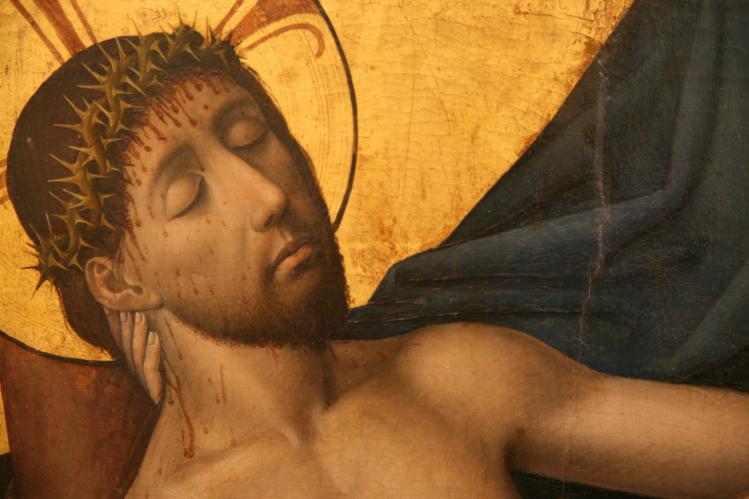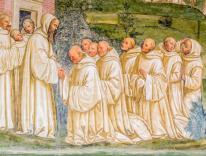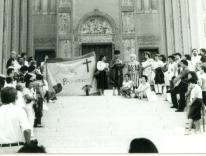
A while back I was asked to write about “what the person of Jesus meant to me.” I took this as a request to describe my personal relationship to Jesus. To my humiliation—and perhaps to my enlightenment—I realized that I didn’t have a clue about how to answer this. Did I even have such a relationship? In faith, I believe that Jesus has a relationship to me—but is this reciprocal? And to what point? In the ordinary course of my days, my chief preoccupation is not to put on the mind of Christ, to refer everything to him as to one constantly accompanying me. My chief preoccupation is trying not to get hurt or bored too much in the give-and-take of daily life.
But there is another way of interpreting the question. It could mean: How do I see Jesus of Nazareth? I see Jesus as the church presents him to me, through Scripture and through the apostolic tradition as defined in the great councils—as true God and true man, one Person in two natures “without separation, without mixture, without confusion and without change.” I take this teaching at its word, very literally. When we affirm that Jesus of Nazareth is true God of true God, that must be understood absolutely. When we affirm that Jesus is true man, that too must be understood absolutely. One of the Holy Trinity, who thundered on Mount Sinai and before whom the seraphim veil their faces, became an insignificant worker in an occupied and oppressed country, was dragged through the streets of Jerusalem as “an utter and ignominious failure” and put to death as a political agitator. Neither of these terms should be watered down even though, psychologically, we cannot conceive them simultaneously. Our faith does not ask us to try to reconcile these absolutes; it asks us to affirm them. Sometimes we will be struck more by the fact that Jesus is every bit as human as you or I; on other occasions it will be the fact that he is God. When we speak of the mystery of the Incarnation, we will necessarily emphasize one or the other of these terms. Any attempt to reconcile the two terms rationally would lead to a diminution of both. I don’t think we should be afraid to follow these affirmations to their necessary consequences. This man who plunks himself down by a well in Samaria, tired, hungry, and thirsty, is the co-eternal Word through whom all things were made.
When we affirm that Jesus is true man, I think this applies not only to his human nature but also to his human destiny. The adage of St. Athanasius that “what has not been assumed has not been redeemed,” which became the rule of orthodoxy during the Christological disputes, tells us something about the way God is man. A human being evolves, learns, is shaped by his surroundings, fears and hesitates, has good days and bad—all this is part of being human, limited and vulnerable. Our God did not play at being man. The human nature that was integrated into the second person of the Trinity was not an abstract human nature; it was taken from the flesh of Mary of Nazareth in the days when Quirinius was governor of Syria. When we speak of the historical humanity of Jesus, then, we are concentrating on one aspect of a scandalous mystery. One of the Holy Trinity became, in all truth, our brother and “like us in every way except sin,” and we affirm everything that this implies. Biblical criticism, rightly used, brings this reality into relief. In his Introduction to New Testament Christology, Raymond Brown concludes that there is no compelling evidence in the synoptic gospels that Jesus ever presented himself as God or had a clear vision of the redemptive nature of his passion and death. This became clear to the church only after Pentecost, and then little by little. Like the rest of us, Jesus had to learn obedience in a certain obscurity, truly resist the temptations that presented themselves throughout his whole life, discover his destiny progressively. Is this incompatible with his divine nature? Chalcedon says no—that God became true man. In this sense, no Christology can be too “low.” Nor can there be a Christology that is too “high.” This very tension is essential to the mystery.
The Congregation for the Doctrine of the Faith has insisted that Jesus of Nazareth had the “beatific vision.” But this does not mean that the vision illuminated his consciousness in such a way that past, present, and future were all perfectly clear to him, or that he always understood his divine identity in all its aspects. Otherwise he would be like an actor merely playing the role of a man—an idea I find repugnant. So how did the beatific vision affect Jesus before his glorification? Perhaps we can imagine it along the lines of how sanctifying grace affects us: it guides us as a kind of instinct when we are faithful to it, and yet it remains beyond our conceptual grasp. Just as sanctifying grace is a participation in the divine life, the grace of the hypostatic union would have been experienced by Jesus as an eternal identity but also as a total poverty and dependence. Jesus, Word of God and son of Mary, would have been aware that he receives absolutely everything from the Father—that without the Father he is nothing—and he would have experienced this as no one else has. The cry of the abandoned Christ on the Cross is that of a divine and human dereliction beyond words, beyond imaginings.
Yet this historical Jesus who walked the streets of Nazareth and Capernaum, who suffered under Pontius Pilate and rose on the third day, is essentially a memory. His presence to me today is otherwise mysterious. His presence is as hidden as it was in Nazareth, where he was simply known as the carpenter, the son of Mary and brother to James and Joseph and Jude and Simon. He has promised to be with us until the end of the world, as he was present in the silence of Nazareth and in the silence of the Cross. His brothers and sisters and mothers will forever be those who, in the depths of their hearts, hear the word of God and keep it, whether they realize it or not. His presence is hidden in the Eucharist and in the people of good will who surround us and who, in the secret of their hearts, shelter Jesus and resemble him—as siblings resemble one another.
St. Gregory of Nyssa wrote: “Never think of the Son without thinking of the Spirit.” The reverse would be equally true: Never think of the Spirit without thinking of the Son. For St. Irenaeus, the Son and the Spirit are “the two hands of the Father” that always work together. This is evident in the gospels. If it is Jesus who promises to send the Holy Spirit to accompany his disciples after his glorification, it is the Spirit who announced Jesus through the prophets; it is through the Spirit that he becomes incarnate in the womb of Mary, is manifested in the waters of the Jordan, is led into the desert, and is resurrected from the dead. In the Eucharist, it is the Spirit that transforms the gifts and is present in the body and blood of Christ consumed by the community. The Spirit reveals and sends Jesus, as Jesus reveals and sends the Spirit, and both reveal the Father. This is an aspect of the Trinity that has often been neglected in the Western Church. Without the Spirit the Word cannot be heard. Without the Word the Spirit is inarticulate.
In the book Examining the Catholic Intellectual Tradition, Robert Imbelli points out that, after a long period of Christo-monism in the church, there is now a sort of Holy Spirit–monism: a vague, generic “spirituality” that neglects Christ. Perhaps the relationship between Word and Spirit is somewhat analogous to the relationship between God and man in Christology. We have difficulty in imagining the two terms simultaneously and tend to oppose them, whereas they are always both present and active together. We oppose the “institutional church,” structured by the Word, to the “prophetic church” structured by the Spirit. But the institutional church should itself be prophetic, the Word leading to the Spirit and the Spirit to the Word. Obviously, this has not always been the case in the church’s history—and it will never be entirely the case until the consummation of the Kingdom—but this is the eschatological reality toward which we tend and for which we hope.
STILL, WHEN I LOOK AT the historical Jesus and the mystery of the church, I’m looking at things from the outside, as it were, seeing them as objects. I can be in awe of these mysteries and the quality of love they manifest, just as I have been in awe of the Alhambra of Grenada, the Cathedral of Chartres, or the Winged Victory of Samothrace, where one passes from simple beauty to irresistible magic. Such an appreciation is, I believe, very good and a kind of grace. By itself, however, it does not put me in contact with the person of Jesus, the Word made flesh, the Life of the world, and the Life of my life. It can remain at the level of a consoling, edifying, and elevating poetic intuition.
True experimental knowledge of Jesus comes only through the Holy Spirit, and it does not come easily. What makes it hard is not any lack of generosity on the part of God but our own opacity. In an article in the February 27, 2004, issue of Commonweal, Rachelle Linner cited a passage from Flannery O’Connor that immediately resonated in me: “Human nature is so faulty that it can resist any amount of grace and most of the time it does.” Most of the time, I am much more aware of this resistance than of whatever might somehow get past it.
There are those who speak of the encounter with the person of Jesus as a pivotal, decisive experience. Such an experience might, indeed, be valid for some. Its authenticity will manifest itself by its fruits. Kierkegaard, on another level, speaks of a decisive act of commitment—and we are constantly summoned to “conversion,” to repent and change. Classical theology has the angels deciding their destiny in a single, unalterable choice. I sometimes dream of being able to imitate such an act, one that would free me from all my ambiguities and contradictions, my half-hearted aspirations and ineffectual resolutions. This is not the way things work, however. For us, the life of faith is not an instantaneous, once-and-for-all decision, but a long series of decisions, a pilgrimage that, like any other journey, includes its share of tedium, confusion, and risk. So my relationship to the living Christ and the life-giving Spirit remains a mystery to me. I entrust myself into the hands of a God who is greatly merciful and knows out of what clay he has fashioned us. He has also said, “He who comes to me, I will not cast out.” I take him at his word.
Please email comments to [email protected] and join the conversation on our Facebook page.
Previous Story
'Effie Gray' & 'Cinderella'
Next Story
Blackballed

